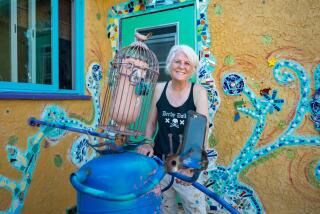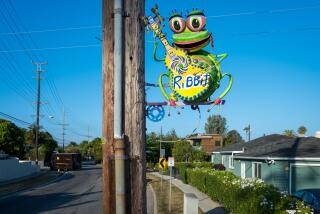Depiction of the Virgin of Guadalupe Stirs Objections
SANTA FE, N.M. — The negative reaction to Santa Monica artist Alma Lopez’s “Our Lady” was slow in coming.
The digital collage depicting the Virgin of Guadalupe wearing only a few sprays of strategically placed roses was featured on 11,000 brochures sent out by Santa Fe’s Museum of International Folk Art last September. The state museum logged just six letters of complaint from people who were offended by the make-over of the Mexican apparition of the Virgin Mary.
Then the work went on display Feb. 25 in an exhibition titled “Cyber Arte: Where Tradition Meets Technology.” Patrons packed the museum’s auditorium to hear Lopez, three other Latina artists whose work is in the show and curator Tey Marianna Nunn talk about mixing folk imagery with computer media. No one complained about “Our Lady.”
But midway through March, phone calls and letters began arriving at the museum and in the offices of New Mexico state legislators and the governor, demanding that Lopez’s artwork be taken down and those responsible fired. About 25 protesters, mostly Latino Catholics, staged a rally on March 23 at a state office building and 300 attended a prayer vigil last Saturday. By then, Archbishop Michael J. Sheehan, head of the Santa Fe archdiocese, had joined the protest--issuing a press release calling for the removal of the collage and an apology from museum officials.
“Here is the mother of God depicted like a tart or a call girl,” Sheehan said in an interview. “The image of Mary depicted this way has no place in a publicly supported museum.”
Joyce Ice, director of the museum, and Tom Wilson, director of its parent institution, the Museum of New Mexico, are adamant that the print should remain on view, and as the controversy has heated up, most of the e-mails and letters they’ve received support that position. Ice and other museum officials have met with protesters and placed a bilingual sign at the gallery’s entrance warning that “some objects in this exhibit may be disturbing to certain viewers.”
“Obviously we’re very concerned about a precedent being set,” said Wilson, who was director of the Southwest Museum in L.A. from 1992 to 1995. “Where does that slippery slope stop? I don’t want to be the first to take down a piece of art because certain elements of the community want to censor it.”
But the Museum of New Mexico’s board of regents may have other ideas. They have called a public meeting today to air both sides of the controversy; they may decide to vote on the fate of “Our Lady.”
Lopez, interviewed in Los Angeles, said she believed the issue had been blown out of proportion. “I’m really surprised. I feel that maybe the archbishop doesn’t quite understand where I’m coming from.”
Born in Mexico and raised in East L.A., Lopez said she grew up revering the image of Our Lady of Guadalupe. Her print was produced with a 1999 city of Los Angeles individual artist grant and has been exhibited in Southern California. According to Lopez, until the furor in Santa Fe, she had received just one letter of complaint and little other negative reaction.
Lopez’s “Our Lady” features a photograph of performance artist Raquel Salinas as the nearly nude Guadalupe. The crescent on which she stands is held aloft by a bare-breasted angel, the image of a friend of the artist, Raquel Gutierrez.
Lopez, who will attend today’s meeting, said she did not intend disrespect but was exploring her personal feelings about the iconic Guadalupe.
“I was wanting to find a meaningful connection with La Virgen de Guadalupe,” she said. “I am relating her to the women in my life, my mom, my grandma, my aunt. They had to be strong to survive, like Christ’s mother.”
Protesters argue that the depiction is an assault on the Catholic culture of New Mexico and that it should not be exhibited in a museum supported by tax dollars.
“Why do we have to pay for the persecution of our beliefs?” asked Phyllis Garde, of Espanola, N.M., at the prayer vigil.
Jose Villegas Sr. of Santa Fe, a leader of the protest, e-mailed Lopez, calling the print disrespectful and irreverent.
“What you consider ‘devotion’ in this type of art is not what my generation was taught by our parents, grandparents and ancestors,” Villegas wrote.
But many Latinos and Catholics support the artwork.
Cynthia Sanchez, director of the state’s Capitol Art Collection, wrote her dissertation on icons including Our Lady of Guadalupe.
“It’s the whole context issue,” Sanchez said. “It’s not an image in a church; no one’s praying to it. [Lopez] is re-contextualizing something. It’s a personal image. I think it’s a tribute to the Virgin.”
Museum donors are expected to make their views known at today’s meeting, Wilson said.
Retired Neutrogena Corp. Chairman Lloyd Cotsen of Los Angeles wrote a letter to the regents last week saying the work should remain on display. He gave the Museum of International Folk Art his $4.5-million, 2,500-item folk art and textiles collection, and provided $2 million to help finance space to house it and endow a fund to manage it. The Neutrogena Wing opened in 1998.
Ice said mediators will be present for the public discussion at today’s meeting. She hopes to encourage participants to address the subtexts of the protest.
“Everyone seems to agree that this art is a flash point for a lot of other issues affecting the community,” said Ice. Among those issues are perceived threats to the traditional culture of northern New Mexico, insider-outsider tensions and the fact that the artist is lesbian, she said.
Supporters of Lopez note the long tradition of artists re-creating Guadalupe. Among them is San Francisco artist Ester Hernandez’s karate-kicking Guadalupe, an etching made in 1975. Yolanda Lopez, also of San Francisco, portrayed herself as Guadalupe, bearing paintbrushes and wearing jogging shoes, in a 1978 tableau vivant. More recently, Santa Fe artist Katherine Wells dressed a Barbie doll in the traditional garb of Guadalupe in her 2000 “Barbielupe.”
Lopez has said her work was inspired in part by writer Sandra Cisneros, who wondered in an essay what Guadalupe looked like under her robes.
“Of course!” Lopez remembers thinking. “Roses are what you’d see if you took off her robes”--a reference to the miraculous flowers of the Guadalupe legend.
The artist said she resented the implication that she has no right to interpret Our Lady of Guadalupe in her art.
“This is everyone’s image,” she said. “Our Lady belongs to all of us.”
More to Read
The biggest entertainment stories
Get our big stories about Hollywood, film, television, music, arts, culture and more right in your inbox as soon as they publish.
You may occasionally receive promotional content from the Los Angeles Times.










